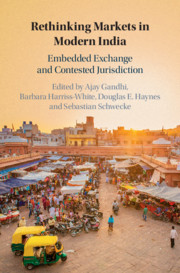Book contents
- Rethinking Markets in Modern India
- Rethinking Markets in Modern India
- Copyright page
- Contents
- Figures
- Tables
- Contributors
- 1 Markets in Modern India: Embedded, Contested, Pliable
- 2 Banking in the Bazaar: The Nattukottai Chettiars
- 3 Space in Motion: An Uneven Narrative of Urban Private Property in Bombay
- 4 Magic of Business: Occult Forces in the Bazaar Economy
- 5 Vernacular Capitalism, Advertising, and the Bazaar in Early Twentieth-Century Western India
- 6 The Artifice of Trust: Reputational and Procedural Registers of Trust in North Indian “Informal” Finance
- 7 Mandi Acts and Market Lore: Regulatory Life in India’s Agricultural Markets
- 8 The Market and the Sovereign: Politics, Performance, and Impasses of Cross-LOC Trade
- 9 Brandism vs. Bazaarism: Mediating Divinity in Banaras
- 10 Black Money in India: Fighting Specters and Fostering Relations
- 11 Market Making in Punjab Lotteries: Regulation and Mutual Dependence
- 12 Liquid Assets: Transactional Grammars of Alcohol in Jharkhand
- 13 Building on Sand? Criminal Markets and Politics in Tamil Nadu
- Index
- References
9 - Brandism vs. Bazaarism: Mediating Divinity in Banaras
Published online by Cambridge University Press: 24 September 2020
- Rethinking Markets in Modern India
- Rethinking Markets in Modern India
- Copyright page
- Contents
- Figures
- Tables
- Contributors
- 1 Markets in Modern India: Embedded, Contested, Pliable
- 2 Banking in the Bazaar: The Nattukottai Chettiars
- 3 Space in Motion: An Uneven Narrative of Urban Private Property in Bombay
- 4 Magic of Business: Occult Forces in the Bazaar Economy
- 5 Vernacular Capitalism, Advertising, and the Bazaar in Early Twentieth-Century Western India
- 6 The Artifice of Trust: Reputational and Procedural Registers of Trust in North Indian “Informal” Finance
- 7 Mandi Acts and Market Lore: Regulatory Life in India’s Agricultural Markets
- 8 The Market and the Sovereign: Politics, Performance, and Impasses of Cross-LOC Trade
- 9 Brandism vs. Bazaarism: Mediating Divinity in Banaras
- 10 Black Money in India: Fighting Specters and Fostering Relations
- 11 Market Making in Punjab Lotteries: Regulation and Mutual Dependence
- 12 Liquid Assets: Transactional Grammars of Alcohol in Jharkhand
- 13 Building on Sand? Criminal Markets and Politics in Tamil Nadu
- Index
- References
Summary
In 2002, India embarked on a plan to promote itself for investment, trade, and tourism with its “Incredible India” campaign, which brought together every possible government sector to market the nation. Now, after a huge influx of multinational products and shopping malls that feature them, global capitalism has transformed India’s commercial culture. “Brandism” has arrived. The bazaar, however, is a site of resistance and mediation to this process. It is an economic and moral system, where products and people are entangled in complex networks, creating, disciplining, and sacralizing various moods and modes of behavior. This is especially the case within the bazaars of the Pakka Mahal in Banaras - a center for religion, culture, and commerce for millennia. Based on nearly two decades of research in these bazaars, my chapter examines the logic and practice of what I call “Bazaarism,” with a focus on the role of reputation and trust in creating solidarities.
- Type
- Chapter
- Information
- Rethinking Markets in Modern IndiaEmbedded Exchange and Contested Jurisdiction, pp. 234 - 268Publisher: Cambridge University PressPrint publication year: 2020

